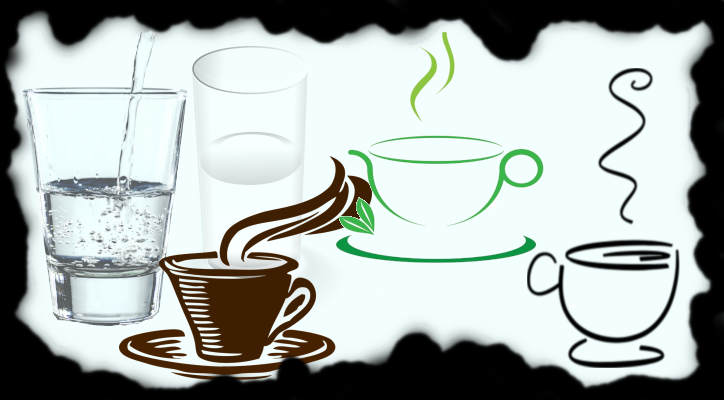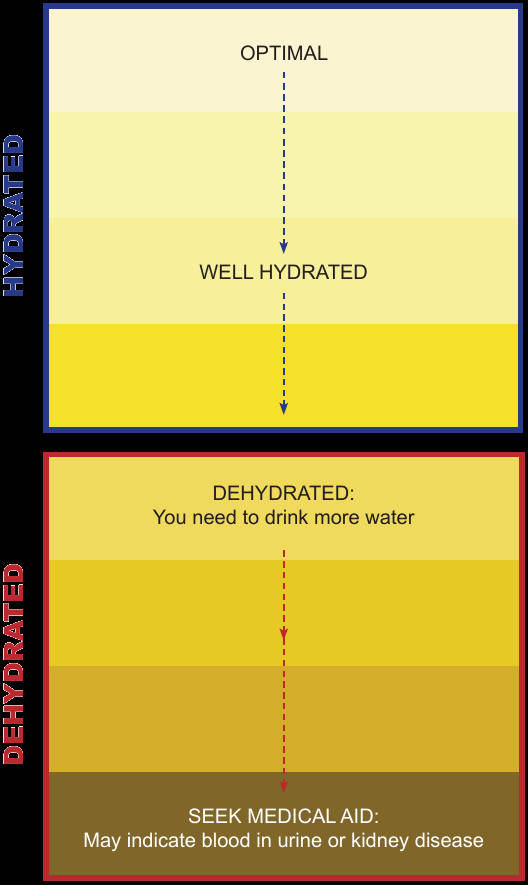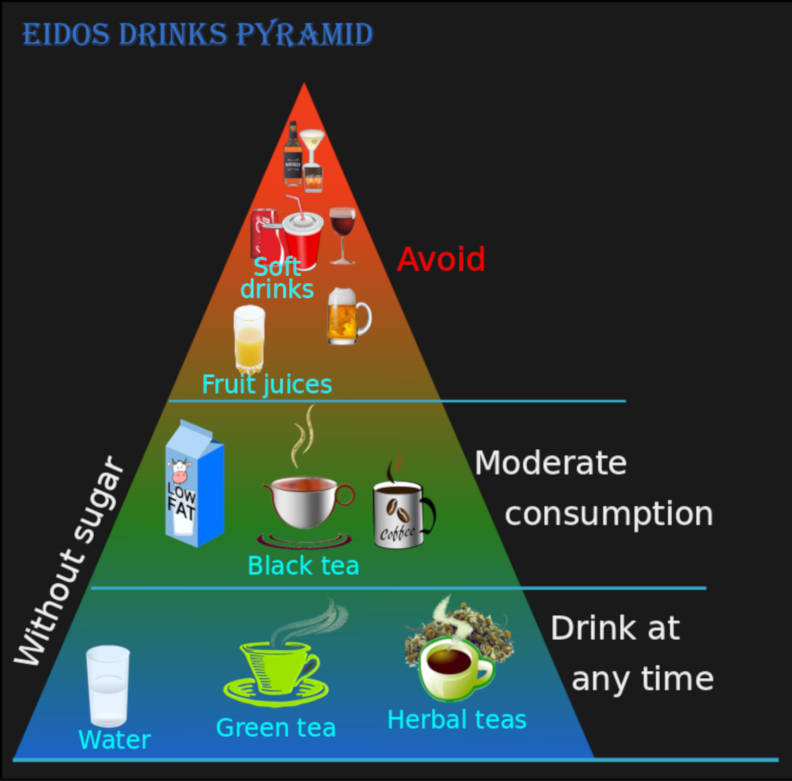NutriScience for everybody
Hydration: The water we need for survival
Water is vital for survival, with good hydration people function well, and to look and feel good. People can survival several weeks without food but only can survival few days without water. People can keep well hydrated drinking a variety of fluids during the day such as teas, coffee, low fat milk, soups in add of drinking water.

Normal water needs range widely due to numerous factors such as metabolism, diet, climate, clothing and other factors; thus, normal hydration is compatible with a wide range of fluid intakes and human water requirements should not be based on a “minimal” intake because might eventually lead to a deficit and possible adverse performance and health consequences[2]. A sedentary adult loses on an average 2–3 littres of water per day through the skin and lungs depending on the climate, air temperature and relative humidity[1].
For adult including advancing age, men and women, the adequate intake of water (AI) is 3.7 and 2.7 litters per day, respectively; for adults, the daily water needs of men approach 2.5 littres if sedentary and increase to about 3.2 littres if performing modest physical activity, while more active adults living in a warm environment have daily water needs of about 6 littres; approximately 1 to 2 littres per day are required to replace obligatory losses for sedentary adults residing in temperate climates[2]
The US National Research Council in 1989 recommended an intake of 30mL/kg body weight after 65 years, and 1 mL of liquid per kcal of energy intake[3].
During physical activity, it is better to be well-hydrated than to be dehydrated. Physical activity results in increased water requirements that parallel sweat losses for evaporation heat exchange[2]. As the physical activity raises body temperature, and, particularly in a warm or hot environment, sweating provides a mechanism to dissipate this excess heat and maintain a stable body temperature[4] it is convenient to drink at less 500 mL of water 20-30 minutes before to perform physical activities. Also it is important to drink fluids during physical activity when is done for long periods in a hot climate for avoiding a risk of dehydration if fluids are not sufficiently replaced.
_______
[1] Jéquier, E. and Constant, F. Water as an essential nutrient: the physiological basis of hydration. European Journal of Clinical Nutrition (2010) 64, 115–123.
[2] Sawka, Michael N. Et al. 2005. Human Water Needs. Nutrition Reviews, Vol. 63, No. 6.
[3] Ferry, Monique. Strategies for Ensuring Good Hydration in the elderly.
[4] Benelam , B. and Wyness, L. 2010. Hydration health: a review. British Nutrition Foundation Nutrition Bulletin, 35, 3–25. ciencedirect.com.
Hydration indicator

Urine Color test chart[1]. The level of hydration is indicated by the color of the urine. Some foods, medications, vitamins and supplements may cause a darkening or changing the color of the urine unrelated to dehydration or health problem.
If you notice color abnormalities in your urine you must see your doctor.
___________
[1] https://www.ius.edu/environmental-heal[...]lth-safety/files/dehydration-chart.pdf
Drinks for hydration
To meet the need for adequate daily intake of water or liquids it is possible to drink a variety of beverages as a substitute for water. Although water has the advantage of meeting hydration requirements without providing additional energy, it is not people's preferred drink. Therefore, it is important to choose good beverages as alternative to meet the right fluid requirements per day.

The Eidos diet suggests drinking a variety of beverages as an alternative to water, such as a combination of different teas, including coffee, black tea, and low-fat milk, but in moderation. Alternative beverages should be taken without sugar. Drinking fruit juices is not recommended because although they are extracted from fruits, the pulp and fiber are eliminated and have a high concentration of natural simple sugars such as fructose and sucrose. In the case of consuming fruit juices, these should be consumed in an amount less than 200 ml a day; it is better to eat the whole fruit. People should also avoid drinking soft drinks and alcoholic beverages.
Teas and herbal teas are rich in phytochemical compounds with nutraceutical properties. Properly prepared, black tea is a good source of fluoride; one cup of black tea per day can provide the adequate daily fluoride requirement. See black and green teas preparation.
It's important to learn to enjoy natural flavors as a new healthy lifestyle, in other words, enjoy drinks without adding sugar. As part of their lifestyle, people should include different drinking beverages distributed throughout the day. Some drinks can be enjoyed by eating a dried fruit such as a date, a dried fig or a dried apricot at the same time.
Tea is the second most commonly consumed beverage in the world after water, and black, oolong and green teas are all produced from the leaves of the plant Camellia sinensis using different processing methods, also there are a wide variety of herbal teas available, for example, chamomile, peppermint and fruit teas, which are often caffeine free[2].
All the studies on hydration found that tea status drinking had no adverse effects on hydration status, indicated by blood and urine markers remaining in the normal ranges and tea provided similar hydration benefits to water, as no statistical differences in blood and urine markers were reported when these conditions were compared[1].
___________
[1] Ruxton, Carrie. 2016. Tea: hydration and other health benefits. CPD, volume 26 number 8.
[2] Jéquier, E. and Constant, F. Water as an essential nutrient: the physiological basis of hydration. European Journal of Clinical Nutrition (2010) 64, 115–123.
Dehydration
Dehydration occurs when water losses are not sufficiently replaced by drinking fluids. When you lose more fluid than you take in, and your body doesn’t have enough water and other fluids to carry out its normal functions; unfortunately, thirst isn’t always a reliable gauge of the body’s need for water, especially in children and older adults[6]. Thirst is often blunted in elderly subjects who are at risk of having an insufficient water intake in conditions of elevated ambient temperature and humidity [1]. Dehydration corresponding to as little as 2% loss of body weight leads to a decreased endurance and risk of heat exhaustion[4]. Extreme dehydration is very serious and can be fatal. More mild dehydration (about 2% loss of body weight) can result in headaches, fatigue and reduced physical and mental performance. It is also possible to consume too much water and in rare cases this can result in hyponatraemia (low levels of sodium in the blood)[3].
Thirst reduction, some diseases such as cholera that produce sever diarrhea, diarrhea are some examples that lead to dehydration.
A better indicator to know if the body is well hydrated is the color of your urine[2].
___________
[1] Jéquier, E. and Constant, F. Water as an essential nutrient: the physiological basis of hydration. European Journal of Clinical Nutrition (2010) 64, 115–123.
[2] The horse’s mouth. 2001. Dehydration: the signs and symptoms. Volume 14, Issue 2.
[3] Benelam , B. and Wyness, L. 2010. Hydration health: a review. British Nutrition Foundation Nutrition Bulletin, 35, 3–25.
Recommended Water Intakes
EFSA 2008 |
IOM 2005 |
WHO 2003, 2005 |
|
Reference values littres/day |
Adequate intakes littres/day |
Requirements littres/day |
|
| Infants 0–4 months |
0.75 |
||
| Infants 0–6 months | 0.1-0.19 /kg |
0.7 |
|
| Infants 6–12 months | 0.8-1 |
||
| Infants 7–12 months | 0.8 |
||
| Infants 8–12 months | 1 |
||
| Infants 12–24 months | 1.1-1.2 |
||
| Children 1–3 years | 1.3 |
1 |
|
| Children 2–3 years | 1.3 |
||
| Children 4–8 years | 1.6 |
1.7 |
|
| Children (boys) 9–13 years | 2.1 |
2.4 |
|
| Children (girls) 9–13 years | 1.9 |
2.1 |
|
| Adolescent boys 14–18 years | 3.3 |
||
| Adolescent girls 14–18 years | 2.3 |
||
| Adult (men) 19–30 years | 3.7 |
||
| Adult (women) 19–30 years | 2.7 |
||
| Adult (men) >19 years | 2.9 |
||
| Adult (women) >19 years | 2.2 |
||
| Adolescent (14+ years) and adult (men) | 2.5 |
||
| Adolescent (14+ years) and adult (women) | 2 |
||
| Pregnant women | 2.3 |
3 |
4.8 |
| Lactating women | 2.7 |
3.8 |
5.5 |
Source: Benelam , B. and Wyness, L. 2010. Hydration health: a review. British Nutrition Foundation Nutrition Bulletin, 35, 3–25.
The importance of hydration

Water is vital for survival, and there is currently great interest in the benefits of good hydration for people to function well, and to look and feel good[4]. Water is among the most important nutrients for the maintenance of life; it is used in the body for transporting nutrients and wastes, regulating temperature, maintaining the structure of tissues, and supporting cell functions, including brain function[3].
Water is essential for life and, although humans can survive for a number of weeks without food, they cannot normally go without fluids for more than a few days[4]. Water comprises from 75% body weight in infants to 55% in elderly and is essential for cellular homeostasis and life[1]. It is normally assumed that the contribution of food to total water intake is 20–30%, whereas 70–80% is provided by beverages[2].
Water is essential for cellular homeostasis because it transports nutrients to cells and removes wastes from cells and also water is important because maintains the vascular volume and allows blood circulation, which is essential for the function of all organs and tissues of the body; the cardiovascular and respiratory systems, the digestive tract, the reproductive system, the kidney and liver, the brain and the peripheral nervous system, all depend on adequate hydration to function effectively[2].
Water is lost by evaporation through the skin and this invisible loss of water represents about 450 ml of water per day in a temperate environment; also there is loss of water by evaporation through the respiratory tract that represents about 250–350 ml of water loss per day[2].
_____
[1] Popkin, Barry M. Et al. 2010. Water, Hydration and Health. Nutr Rev. 68(8): 439–458.
[2]Jéquier, E. and Constant, F. Water as an essential nutrient: the physiological basis of hydration. European Journal of Clinical Nutrition (2010) 64, 115–123.
[3] Ferry, Monique. Strategies for Ensuring Good Hydration in the elderly.
[4] Benelam , B. and Wyness, L. 2010. Hydration health: a review. British Nutrition Foundation Nutrition Bulletin, 35, 3–25.
eidos-project.net © 2016- 2025